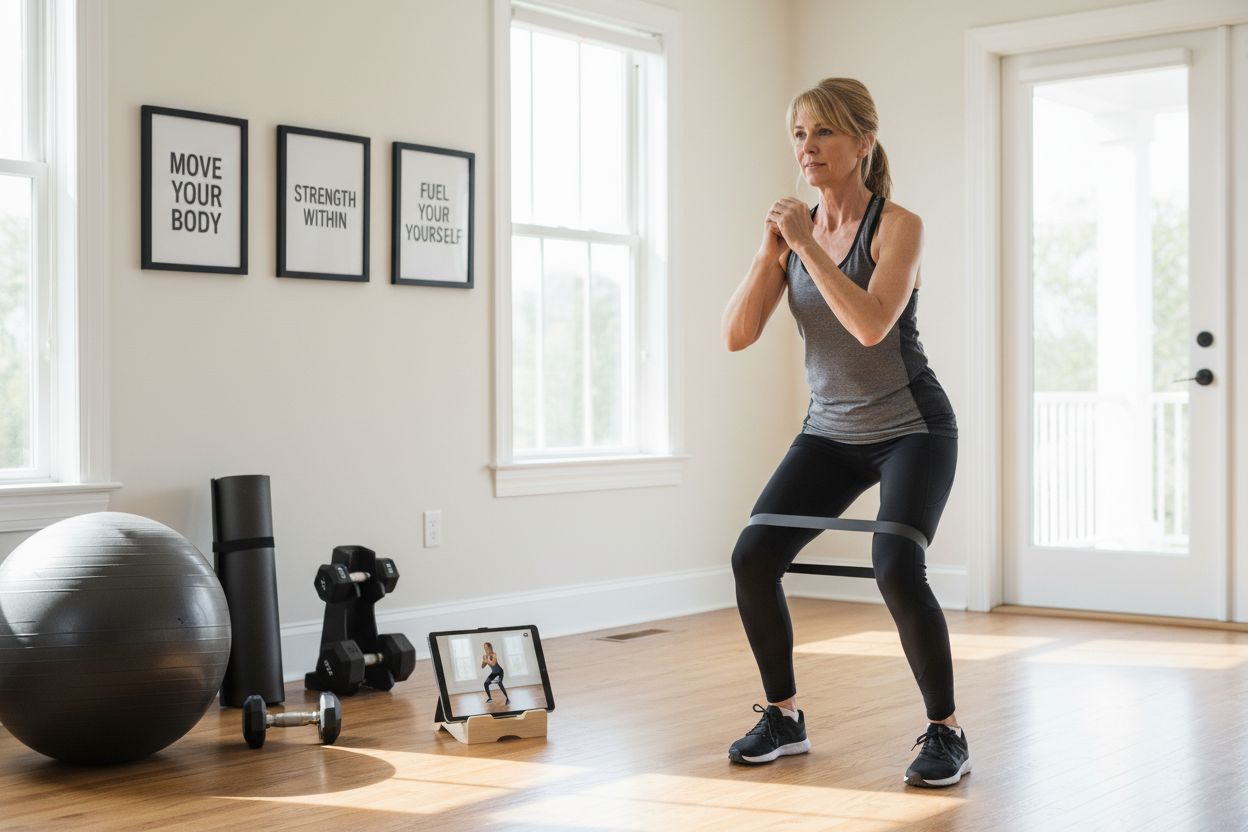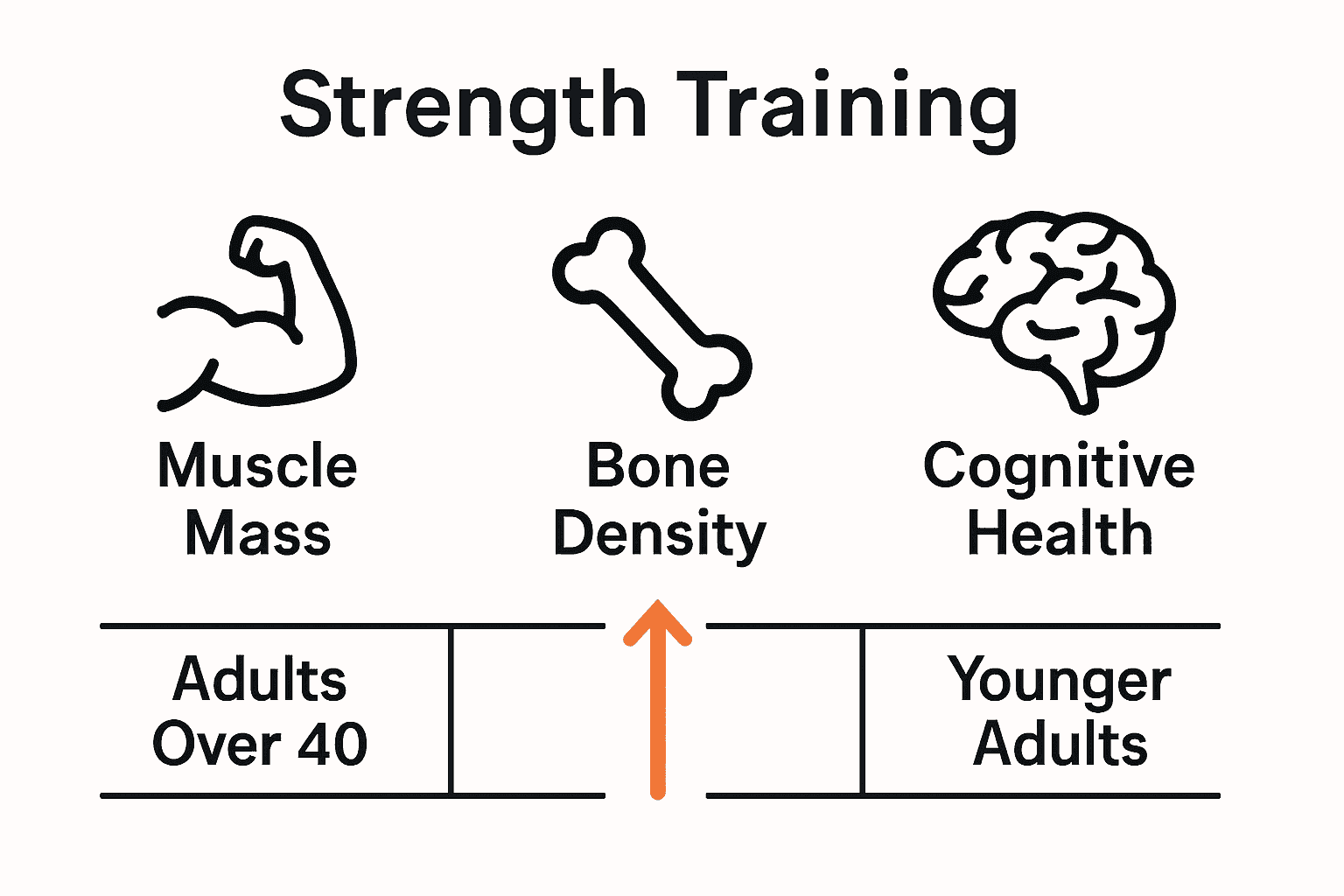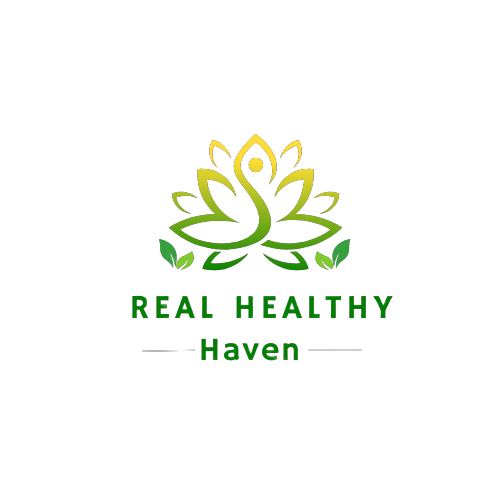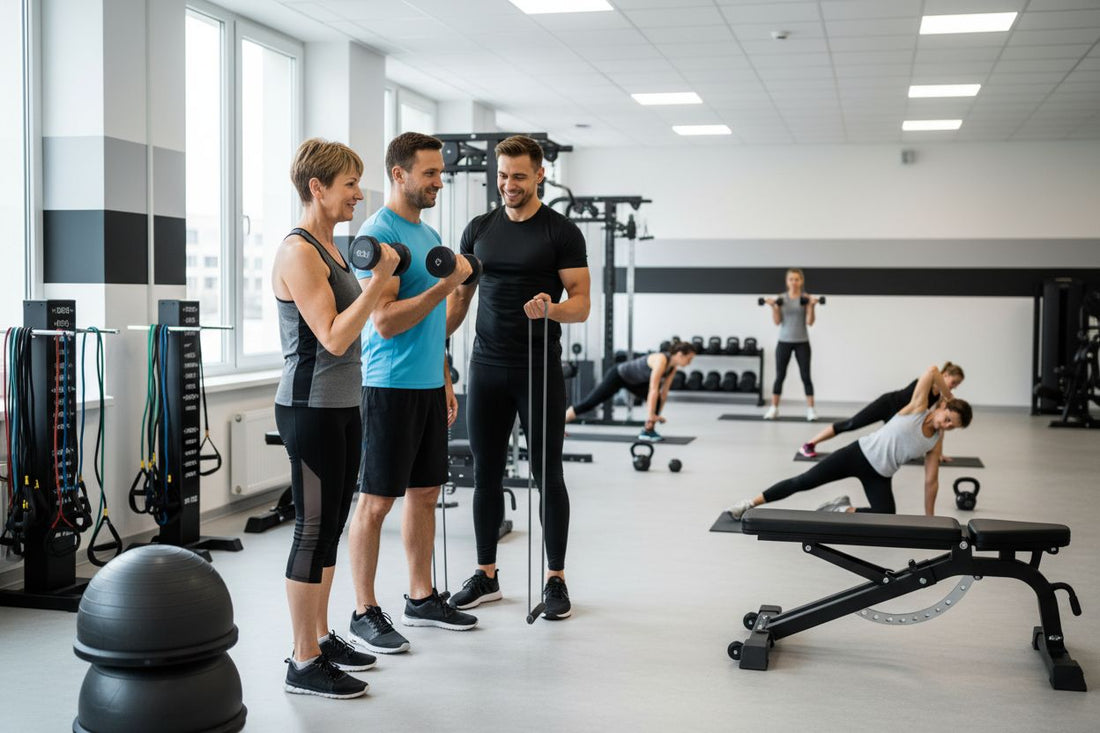After age 40, people can lose as much as 8% of their muscle mass every decade, which impacts strength, balance, and independence. This shift makes strength training more than a workout routine—it becomes a vital strategy for staying active and healthy. Safe and consistent resistance exercises can protect muscles, support bone health, and help adults over 40 enjoy a more energetic, confident life as they age.
Key Takeaways
| Point | Details |
|---|---|
| Muscle Maintenance | Strength training after 40 focuses on preserving muscle mass and enhancing functional fitness for better health outcomes. |
| Unique Health Benefits | Strength training provides critical advantages, including improved bone density, cognitive function, and metabolic health tailored to older adults. |
| Myth-Busting | Common misconceptions about age and strength training can deter individuals; it is essential to understand that older adults can safely build muscle and improve wellness. |
| Safe Practice | Emphasizing gradual progression, proper technique, and safety strategies is vital for preventing injuries and ensuring sustainable training. |
Table of Contents
- Defining Strength Training After Age 40
- Unique Benefits For Adults Over 40
- Common Misconceptions And Myths Debunked
- Physiological Changes And Exercise Adaptation
- Risks, Safety Tips, And Injury Prevention
- Essential Equipment And Resources In Canada
Defining Strength Training After Age 40
Strength training after 40 isn’t about becoming a bodybuilder. Muscle maintenance becomes your primary goal. This strategic approach focuses on preserving muscle mass, improving functional fitness, and supporting overall health during a critical life stage.
According to the Canadian Longitudinal Study on Aging, adults engaging in strength training experience profound benefits. Key advantages include:
- Enhanced mobility
- Improved balance
- Better body composition
- Increased perceived healthy aging
McMaster University’s 5-year research revealed compelling insights about resistance training for adults over 40. Their study demonstrated that targeted exercise programs can help individuals not just maintain, but potentially improve:
- Muscle strength
- Cardiorespiratory fitness
- Overall physical capabilities
Strength training at this stage isn’t about lifting massive weights. It’s about smart, consistent resistance exercises that work major muscle groups safely and effectively. Think controlled movements, proper form, and listening to your body. Your workout should challenge you without risking injury.
The right approach transforms strength training from a competitive activity into a sustainable health strategy. By focusing on gradual progression, proper technique, and regular practice, you’re investing in your long-term physical independence and quality of life.

Unique Benefits for Adults Over 40
Muscle preservation becomes far more than a fitness goal after 40 – it’s a critical health strategy. Health & Wellness Canada highlights that strength training delivers comprehensive wellness benefits uniquely tailored to mature adults.
Beyond building muscle, strength training offers transformative health advantages:
- Bone Density Protection: Reduces fracture risk by up to 51%
- Metabolic Boost: Increases resting metabolic rate
- Cognitive Function: Supports brain health and reduces decline risk
- Mood Enhancement: Naturally elevates emotional well-being
According to Canadian fitness research, muscle mass declines approximately 3-8% per decade after age 30. Strength training counteracts this natural deterioration by:
- Preserving lean muscle tissue
- Improving insulin sensitivity
- Reducing systemic inflammation
- Supporting long-term physical independence
This isn’t just exercise. It’s a deliberate investment in your future health. By engaging in consistent, intelligently designed strength training, you’re building resilience, protecting your body’s fundamental systems, and creating a foundation for vibrant, active aging.
Here’s a comparison of the unique benefits strength training provides adults over 40 versus younger adults:

| Benefit | Adults Over 40 | Younger Adults |
|---|---|---|
| Muscle Preservation | High priority Counteracts loss |
Muscle gain focus |
| Bone Density | Protects against fractures | Builds peak bone mass |
| Metabolic Health | Boosts resting metabolism | Supports growth/metabolism |
| Cognitive Function | Reduces cognitive decline risk | Supports learning and memory |
| Mood Enhancement | Elevates well-being, reduces stress | Improves mood, less pronounced |
| Independence Support | Maintains mobility and autonomy | Enhances performance |
Common Misconceptions and Myths Debunked
Age is not a limitation when it comes to strength training. Many adults over 40 hesitate to start, believing myths that can prevent them from experiencing significant health benefits. Lifeline Canada reveals that these misconceptions are preventing many from improving their overall wellness.
Common myths about strength training after 40 include:
- “It’s too dangerous for older adults”
- “I’m too old to build muscle”
- “Strength training will cause injury”
- “Cardio is more important than weights”
The Health Insider provides remarkable evidence that challenges these beliefs. Their research demonstrates that:
- Even 90-year-olds can safely reverse muscle loss
- Strength training effectively combats sarcopenia (muscle wasting)
- Proper training reduces fall risk
- Resistance exercises support mental health and cognitive function
The key is starting gradually and seeking professional guidance.
Contrary to popular belief, strength training isn’t about lifting massive weights or pushing your body to extreme limits. It’s about consistent, controlled movements that build strength, improve balance, and enhance overall quality of life. Every rep is a step towards maintaining independence, preventing age-related decline, and proving that age is just a number.
Physiological Changes and Exercise Adaptation
As we age, our body undergoes significant physiological transformations that directly impact how we approach strength training. McMaster University’s research reveals that respiratory muscle strength declines 8-10% per decade after age 40, making strategic exercise adaptation crucial for maintaining physical fitness.
Key physiological changes include:
- Reduced muscle protein synthesis
- Decreased tendon elasticity
- Lower hormone production
- Slower recovery times
- Reduced cardiovascular efficiency
Eccentric training emerges as a particularly effective approach for mature adults. Eccentric exercise research demonstrates unique benefits:
- Provides high muscular overload
- Minimizes cardiovascular strain
- Supports tendon health
- Reduces injury risks in aging muscle systems
The body doesn’t deteriorate – it adapts. By understanding these physiological shifts, you can design workouts that work with your body, not against it. Slower, controlled movements, longer recovery periods, and targeted resistance exercises become your allies in maintaining strength, mobility, and overall functional fitness.
Adaptation is the key. Your strength training after 40 isn’t about competing with younger athletes, but about creating a sustainable, intelligent approach that respects your body’s changing capabilities while continuously challenging its potential.
Risks, Safety Tips, and Injury Prevention
Strength training after 40 demands a strategic approach that balances challenge with caution. Understanding potential risks and implementing smart preventative measures becomes crucial for maintaining long-term fitness and avoiding potential injuries.
Critical safety considerations include:
- Comprehensive medical clearance before starting
- Gradual progression of intensity
- Proper warm-up and cool-down routines
- Listening to your body’s signals
- Using correct form and technique
Emerging research suggests innovative approaches to injury prevention. FlexGuard research introduces wearable feedback systems that could revolutionize how mature adults train by providing real-time guidance and movement analysis.
Prevention strategies to minimize injury risks:
- Start with lighter weights
- Focus on controlled, deliberate movements
- Incorporate flexibility and mobility work
- Allow adequate recovery between sessions
- Work with a qualified trainer experienced in training mature adults
Your body is not a machine to be pushed to its breaking point. It’s a sophisticated system that requires respect, intelligent training, and mindful progression. By prioritizing safety, understanding your unique physiological limitations, and adopting a patient approach, you transform strength training from a potential risk into a sustainable path toward enhanced health and vitality.
Essential Equipment and Resources in Canada
Home gym setups and accessible training resources are crucial for adults over 40 looking to maintain consistent strength training. McMaster’s community-based MacSeniors Exercise and Wellness Program demonstrates how structured programs can provide professional guidance and supportive environments for mature fitness enthusiasts.
Basic equipment recommendations for home strength training:
- Adjustable dumbbells
- Resistance bands
- Stability ball
- Yoga mat
- Light kettlebells
- Bodyweight exercise space
Key resources for adults starting strength training:
- Local community fitness centers
- Senior-focused exercise classes
- Online tutorial platforms
- Professional fitness consultations
- Physiotherapist-recommended programs
Technology has transformed fitness accessibility. Digital platforms now offer tailored workout programs, virtual coaching, and progress tracking specifically designed for adults over 40. These resources eliminate intimidation, provide structured guidance, and create personalized fitness experiences that respect individual physical capabilities.
Remember, equipment doesn’t define your fitness journey – consistency, proper technique, and gradual progression do. Whether you’re using professional gym facilities or creating a modest home setup, the most important investment is your commitment to maintaining strength, mobility, and overall health.
Unlock Your Strength After 40 With Tools That Work For You
You have learned how strength training after 40 is essential for muscle maintenance, protecting bone density, and ensuring long-term independence. But moving from learning to action can be tough if you do not have the right support. Maybe you have struggled to find fitness equipment designed for mature adults or felt unsure about which wellness products actually help with real-life goals like mobility, balance, and safe progression.

Do not let these challenges stand between you and your best health. At Real Healthy Haven, we offer curated fitness gear, health monitors, therapeutic supplies, and comfortable activewear created for the needs of adults over 40 in Canada. Ready to put this knowledge into action? Browse top-quality products and discover practical solutions for thriving through every workout. Visit our main site now and take the next step on your strength journey today.
Frequently Asked Questions
What are the benefits of strength training after age 40?
Strength training after 40 offers numerous benefits, including enhanced mobility, improved balance, better body composition, increased perceived healthy aging, bone density protection, metabolic boost, cognitive function support, and mood enhancement.
Is strength training safe for adults over 40?
Yes, strength training is safe for adults over 40, especially when conducted with proper form, gradual progression, and professional guidance. It’s essential to start light and consult a healthcare professional before beginning any new exercise regimen.
How can I start strength training if I’ve never done it before?
Begin with controlled movements using light weights or resistance bands, focus on proper technique, and gradually increase intensity. Consider joining beginner classes or working with a qualified trainer to ensure safe and effective practices.
What equipment do I need for strength training at home?
Basic equipment for home strength training includes adjustable dumbbells, resistance bands, a stability ball, a yoga mat, and light kettlebells. You can also perform bodyweight exercises without any equipment to start building strength.



